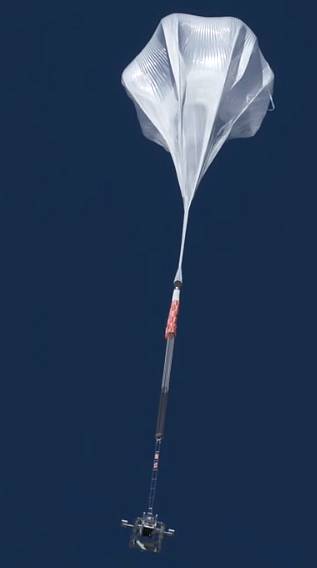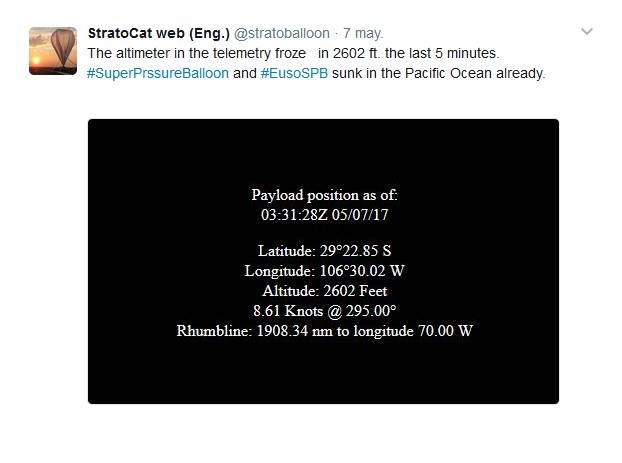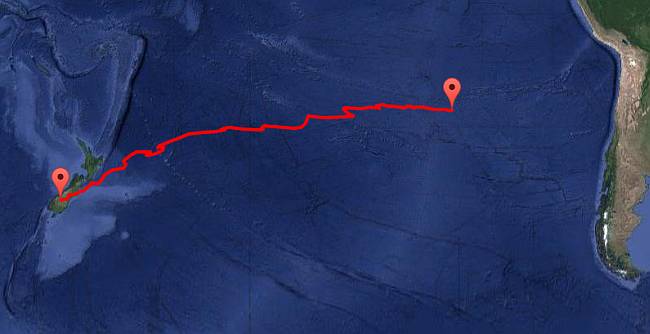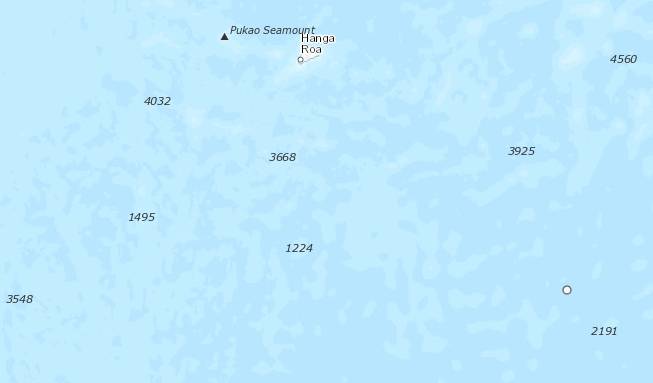News Archive
A farewell to EUSO-SPB

This was published by Etienne Parizot, scientist member of the EUSO-SPB team on its facebook page a few days after the balloon loss. I prefer to reproduce here the original version in French, essentially to avoid a bad translation that surely would not do justice and could change the meaning of such beautiful words
#RIP, EUSO-SPB
Voilà que je le vis sombrer, sourd et secret vers le silence…
Lorsqu'il heurta les eaux d'abord il ne comprit pas la violence. Sa jupe de panneaux solaires si soudainement arrachée ne fut plus qu'une masse informe reliée à son corps suffoqué par des lambeaux de crinoline. Il crut un temps pouvoir flotter, se rétablir et, dérivant, rejoindre le havre improbable de quelque archipel oublié. Mais les pesanteurs le gagnèrent, et il s'engouffra lentement…
Puis les vacarmes s'estompèrent et le silence s'établit. Il s'enfonça dans l'océan, happé dans le flou des abysses, toujours plus bas, toujours plus lent, plongeant comme un astre perdu dans la nuit qui l'avait rêvée, dérangeant le repos de l'onde et dans son sillage impromptu, glissant comme une ombre discrète, laissa s'échapper, irisées, quelques rares bulles d'hélium, derniers souvenirs des hauteurs où sa gloire l'avait porté, intriguant la faune inconnue qui dans ces profondeurs s'efface, et descendit comme un oubli vers les solitudes immenses…
Combien de temps portera-t-il l'ivresse de ses créateurs, qui l'avaient conçu conquérant les espaces interstellaires, portés par le chant du cosmos, et répondant à leur manière aux mystères incandescents de cet appel de la lumière ?
Dans un dernier choc étouffé, voilà qu'il touche enfin le fond. Vaincu. Si tragique et si beau, le flanc reposant sur le sable… Plus rien ne le viendra troubler : ni les tempêtes redoutables, ni les tourmentes sous-marines, ni le souvenir des vivants. Les millénaires à venir sont déjà son lointain passé…
Déjà la paix se recompose. Et dans le sommeil pélagique où se perdent ses vérités, s'éteint aussi notre mémoire… Loin au-dessus, à la surface, la mer a calmé ses ardeurs. L'écume élevée par sa chute est depuis longtemps retombée, et les vents ne sont plus salés que des embruns du souvenir.
Mais quel est ce frémissement que l'on sent couver sous les vagues ? Peut-être les flots fécondés dans le secret d'un antre hadal se savent-ils déjà hantés par cette fièvre sidérale qui fut en leur sein déposée. Car dans leur ondoiement serein, ourlés de subtiles lueurs, semblent parfois se refléter, parmi les ombres végétales, le léger frisson argenté du scintillement des étoiles…
-
May 19 2017
NASA's Super Pressure Balloon has sunk in the Pacific Ocean
In this entry I will discuss some facts around the failure of NASA's Super Pressure Balloon, launched as mission 679NT from Wanaka, New Zealand on April 24, 2017, transporting onboard an instrument known as EUSO-SPB (Extreme Universe Space Observatory) with the goal to detect ultra high energy cosmic rays. I suggest, for context purpose, to read the earlier article on the mission published in May 2th.
It's been more than a week since the loss of NASA's Super Pressure Balloon (SPB) and I've expected to have by now enough elements to make a more detailed account of what happened. The reality is that the long silence from NASA that accompanied the development of the mission after launch, has extended this time. Thus, I'm being forced to make a more subjective post than I would like with the little amount of information available. Anyway, I think several interesting elements are worth of analysis.
###################
The night of Saturday May 6th. was for me a little more bitter than expected. I was following the morning path of NASA's superpressure balloon as it passed south of the Pitcairn Islands, and then followed closely it's movements during the afternoon as it approached to Easter Island. I even hoped that the shiny apparition of the flying pumpkin near the island could be caught by one of the webcams of the Mataveri Airport, but finally the balloon maintained a course far south of the Moai home (the closest distance to the island was 220 kilometers).

As night arrived, I was ready to log again the altitude loss, which was a repeating act since the second night aloft. As I mentioned in my previous post, that was indication of a possible leak in the balloon which could not maintain buoyancy as soon as the sun sets.
Around 23:12 utc on May 6th, I've published on Twitter what would be the last status on the balloon flight. I've marked that the SPB was still 3800 km from the South American coast, and that it must reach land before depleting all ballast remaining.
As expected, around 00:12 utc, with the sun below the horizon, the SPB started it's way down. One hour after it was at 97.000 ft and descending, but by 2:45 utc it hit the lowest point of the entire flight, 50 kft and descending to 47.000 ft. Something was definitively bad.
As the log entries were updated 4 times per hour, I've decided to switch to the CSBF tracking page which showed readings from the onboard GPS system almost in real time. There, updating the page every two minutes, the numbers demonstrated a steady and fast decrease of altitude: the SPB was falling like a stone.
My first guess was that the balloon was failed and finally was falling to the Ocean surface. At that moment it was located 3200 km from the coast and the closest land was Easter Island 370 km to the northwest. It was in the middle of nowhere. A second possibility was that the mission had already been terminated.
I've continued monitoring the descent of the balloon and it's cargo until around 3:30 utc when the altimeter stalled in 2602 feet. A few minutes later I shared on Tweeter that last capture with the final numbers of the mission.
Without intention, the black screen resembled some kind of epitaph for a troubled mission.

45 minutes after the impact, official word was spread: "...Third mid-latitude super pressure balloon flight complete; good data from science and balloon. Still eyeing 100 days!...", a certainly awkward title to refer to a balloon/payload just smashed against the ocean surface.
As always occurs in this kind of situations -not only with NASA to be fair- reading the statement, a person who was not following the mission in detail could be led to think that the flight was a success.
What NASA says and does not say
In spite of the succinct and precise words of the press release, from its reading can be inferred some interesting details
Regarding the termination decision the question is clear: NASA decided to finish the mission when any chance of reaching land was lost. While the SPB was in the middle of the Pacific Ocean and with little ballast remaining to safely compensate the loss of altitude each night, the only help to complete the trip as fast as possible could be a big push of the winds. In 2015, during the 1st. mission of the SPB the balloon moved east at 40 knots average, completing the crossing of the Pacific in 140 hours. However, this depends heavily on the altitude of flight. By the time the SPB performed the crossing in 2015 there was no indication of any leak and it maintained a pretty constant altitude. Quite the opposite, this year, due to the up's and down's the SPB showed a clear pattern in terms of horizontal movement: it gained some eastward momentum while it was at it's "normal" altitude about 109.000 ft during the day, but once descended below 90.000 ft at night it stalled or even moved backwards pushed by the winds prevailing there. That's the reason for the "dented" pattern on the track below.

The termination process was very different from other NASA missions. Generally speaking, when a balloon mission is terminated, the payload is separated from the balloon and starts a descent under its own parachute. At the same time, one gore of the balloon is split open from top to bottom making it to vent all helium and collapse, falling also to the ground. In the case I'm commenting here, apparently the balloon flight was "terminated" but the balloon was not separated from the payload, and fell to the ocean surface still attached to the payload. Using this technique, the payload acts like a counterweight or anchor that drags the balloon fabric to the bottom of the sea with it. By doing this, NASA prevents the balloon from the possibility of remaining on the ocean surface and near most marine life.Below these lines we can see a topographic ocean map of the zone of the impact showing the deep values in meters. The impact point is shown as a tiny circle at lower right.

Regarding the failure, the press release mentions that NASA discovered the leak on the SPB since it's third night aloft, although nothing was published or communicated about. The first testimony of the agency coming out with that revelation occurred in an article which appeared in the Otago Daily Times the day after I've disclosed for the first time in this website my suspicions that the balloon was in problems.About the character of the mission the article also resurfaces the magic word "test", which was almost absent from publications about the preparation of the mission and the chronicles of the successful launch. All people following the recent developments of NASA's SPB know well that this technology is still to be proven reliable. And that is -in my humble opinion- the first mistake made by the agency: to show a still immature technology as a well proven and tested one, a technology ready to "make groundbreaking science". If NASA would've put more emphasis on remarking about the technological character of the mission, its adverse end wouldn't have had the impact of the unexpected.
Similarly, coming from a 46-day mission -during which the same fault occurred although less catastrophically- a wise measure would be to lower the expectations both for public and scientific community, fixing a less ambitious goal than the "holy grail" of 100 days aloft. The absence of no intermediate goals demonstrates an eagerness to show achievement, or to achieve goals which the SPB technology at its current point perhaps cannot maintain.
Regarding the scientific experiment onboard the press release includes words from Angela V. Olinto, professor at the University of Chicago and principal investigator (PI) of the EUSO-SPB instrument: "...The international EUSO Collaboration is deeply thankful for the support, expertise, and dedication of NASA to this historic opportunity to open a new window onto the universe...". Adding that "...Our flight was cut short, but we are confident that the super pressure balloon approach to observing the most energetic cosmic particles will pioneer a new understanding of these extreme phenomena...".
"...EUSO-SPB performed well, and more than 60 GB of data was downloaded to ground..." said, Lawrence Wiencke, professor at the Colorado School of Mines and deputy PI for the EUSO-SPB flight. "...We are looking forward to analyzing the data and to another super pressure balloon flight with NASA...".
In a more poetic side, Etienne Parizot, scientist from Paris Diderot University, expert in Astrophysics, Astronomy, and Theoretical Physics wrote a beautiful "farewell" to the instrument and published it in its facebook page. I've reproduced the text, in the original version in French, essentially to avoid a bad translation that surely would not do justice and could change the meaning of such beautiful words (left column, above).
Regarding the future, in an article appeared also in the Otago Daily Times newspaper on May 9, we read "...Nasa had yet to determine whether it would return to Wanaka for a fourth consecutive year to launch another balloon in 2018 or use its site in Sweden...". The Sweden site refers to the agreement with the European Space Range (ESRANGE) launch site near Kiruna, from where NASA launched transatlantic missions to Canada.
The agency performed two tests flights of the SPB (then known as Ultra Long Duration Balloon or ULDB) from ESRANGE in 2006 and 2009. That was during the initial stages of development of the balloon when NASA was trying to figure out the problem of correct the unfolding of the balloon fabric during pressurization. These flights were aimed to perform a test which would pass through 3 day/night cycles maximum, to evaluate the balloon behavior and having still great chances of recovering it from the Canadian tundra. However, both missions were terminated early in the crossing due to structural failures in the balloons.
Which the mention of the Sweden site means in this context, is that NASA could be evaluating to return the SPB to a testing phase. A phase that -in the opinion of many, me included- should not have left so soon.
Has the NASA balloon program followed the right approach on the SPB development?. That is debatable.
During a meeting of the NASA Balloon Working Group (BWG) whose purpose is to provide input to NASA management on the needs and requirements of the users, one of the documents published by the group mentions what I think is the core of the problem. To be honest, that document is from 2003, which was a crucial moment for the ULDB program before some design issues were resolved. However, the nature of the problem still remains the same, and is related to the path the agency choose for the development of the program.
The document is entitled "Remarks on ULDB Development Paths" and the author is W. Wiscombe. Although it seems to be some kind of internal note for the group, it shows the core of the problem here. I do not want to bore you with a long speech but a single paragraph it's a good sample of what is trying to express: "...A technology development program calls for caution and incremental steps; letting the operational program force the development program into a dangerous and precipitous rush to huge size was, in my view, a fatal mis-step, and step that led us into the current crisis..."
The entire document is available here.
-
Share this on social media


